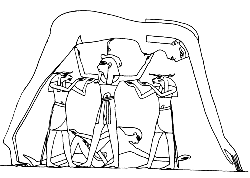
Göttin des Himmels, die man sich als über die Erde gebeugt vorstellte, mit ihren Händen und Füßen an den Ecken der Erde und ihrem Kopf im Westen. Die Sonne bewegte sich täglich entlang ihres Körpers nach Westen, und dort angelangt, wurde sie von Nut verschluckt. Während der Nacht bewegte sie sich durch ihren Körper nach Osten, bis sie sie am nächsten Morgen im Osten wieder gebar. Dieser Zyklus ist insbesondere auf den Decken der Gräber im Tal der Könige abgebildet, erscheint aber auch in Tempeln. Die Ägypter hofften, nach ihrem Tod täglich, wie die Sonne, wiedergeboren zu werden und unter den Sternen zu leben. So wurde Nut zur Totengöttin, die sich beschützend über dem Verstorbenen ausstreckte und durch die der Verstorbene wieder auferstehen konnte. Von einer frühen Zeit an wurden Sarkophag und Grab mit Nut identifiziert. Sogar im Alten Reich war die Decke der Grabkammer mit Sternen dekoriert oder der Sarkophag wurde 'Mutter' genannt. Viele Särge aus späteren Epochen haben ein Bild der Nut auf der Innenseite des Deckels - sie streckt sich wortwörtlich über dem Verstorbenen aus. Zusätzlich zu den Vorstellungen von Wiedergeburt und Schutz wird Nut auch dargestellt, wie sie dem Verstorbenen Nahrung, Wasser und kühle Luft reicht. Diese Bilder weisen auf eine Verbindung zwischen Nut und Hathor, der Beschützerin der Toten, hin. Wie letztere konnte Nut als Baumgöttin dargestellt werden, die dem Verstorbenen Wasser gibt. In der Neunheit von Heliopolis ist Nut die Gattin des Erdgottes Geb, ihres Bruders. Sie ist von ihm durch ihren Vater Schu, den Gott der Luft, getrennt. Nut ist die Mutter von Osiris, Isis, Nephthys und Seth; manchmal wird auch Horus als ihr Sohn bezeichnet. Plutarch erzählt, daß der Sonnengott Helios (das griechische Äquivalent des Re) Rhea (Nut) mit einem Fluch belegte und ihr verbot, an irgendeinem Tag des Kalenderjahres zu gebären. Dank des Eingreifens des Hermes (Thoth) wurden dem Jahr fünf epagomenale Tage hinzugefügt, an denen Nut ihre fünf Kinder gebar, zu denen auch Apollo (Horus) gehörte. Nut wird gewöhnlich als Frau, manchmal mit den Hieroglyphen ihres Namens auf dem Kopf, dargestellt. Häufig beugt sie sich über die Erde, dabei ist ihr Körper mit Sternen bedeckt. Gelegentlich hat sie Flügel als Zeichen der Kühle und des Schutzes, die sie gibt. Sie wird auch in Gestalt einer Kuh abgebildet.